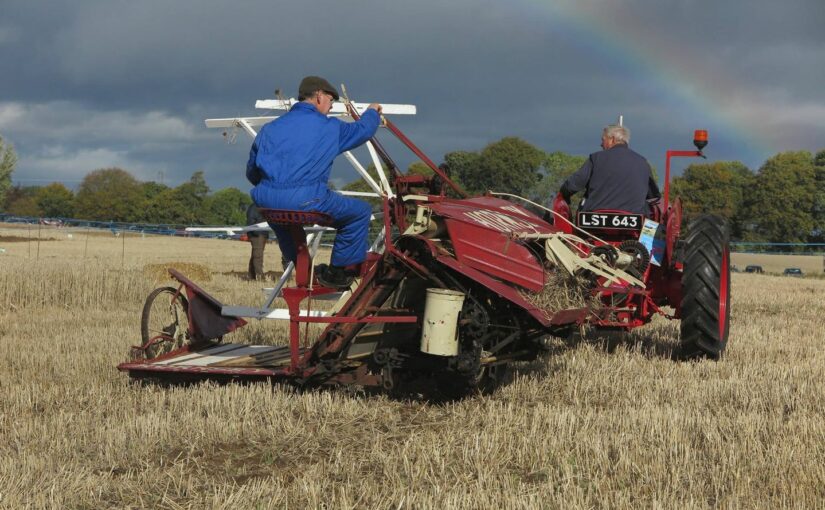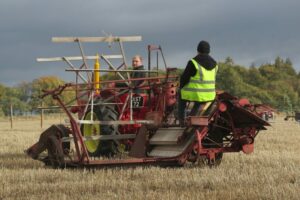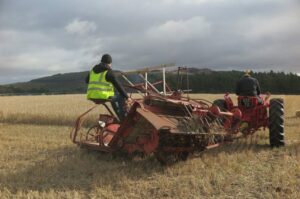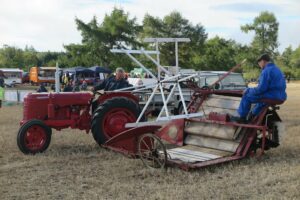There were a number of local trials of binders held by local agricultural organisations in the late 1880s and early 1890s. While some of the accounts of them were very short, others were much more extensive and provide great detail about the trial, including the machines entered and how they worked. They give a flavour of the event, its importance and the work carried out. The accounts were important for helping to disseminate information on binders, how they worked, and what they could achieve in the field.
The following is a selection of reports of trials of binders from this period.
Trial of harvest binders at Crathes (Aberdeen press and journal, 18 September 1888)
“Although no public trials of binders under the auspices under the auspices of the Royal Northern Agricultural Society have taken place, there have been semi-public trials in different parts of the country. The binders appear to be replacing the old reapers, and in a few years they will probably be the only implement of the kind in use. Yesterday one of Hornsby’s new binders started work at Mr Adam Todd’s farm, Milton of Drum, at Crathes Station, when a very large number of persons visited the harvest field. Amongst those present were noticed Mr Irvine of Drum, convener of the county; Colonel Innes, yr, of Learney; Mr Collie of Knappach, Mr Davidson, factor, Crathes; Mr Nicol, Upper Auguston; Mr Still, Nether Anguston; Mr Hunter, Crathes; Mr Ross, Crathes, &c. This binder has several improvements this year, and though the crop was heavy and there was a great sole of grass it gave the greatest satisfaction to everyone present. The machine cut as low as any grass mower, and so perfect is the cutting and gathering power that no grass chokes it. This year the sheaf is smaller, a great improvement on the old “ill to win” sheaves. So pleased were many of the farmers with the new binder that several orders were given for delivery next season to Mr George Bruce, Aberdeen, the local agent.”
Trial of binders (North British agriculturist, 28 August 1889)
“A trial of binders, under the auspices of the Fettercairn Farmers’ Club, took place on a field belonging to Mr Cameron, brewer. The field, which almost adjoins the market stance, was visited during the afternoon by a large number of spectators. There were two machines, “Massey’s” and “McCormick’s”. There was no judicial decision given, but both machines performed their work in an admirable manner.”
Trial of binders in Banffshire (North British Agriculturist, 9 September 1891)
“On Saturday, on two fields on the farm of Braco, Keith, there was an exhibition of binders. Five machines took part in the trial, viz Blairgowrie, shown by Messrs Bisset & Son; the Woods, shown by Messrs B. Reid & Co., Aberdeen; the Massey, shown by Messrs G. W. Murray & Co., Banff; the McCormick, shown by Messrs Smith & Sons, Aberdeen; and the Brantford, shown by Messrs B. Reid & Co. All the machines, with the exception of the Blairgowrie binder, were of American design. Each machine had to cut and bind an equal plot of standing barley in one field, and in another field, on a slope, the machines followed in rotation, the barley crop being considerably lodged. Despite the softness of the ground, and the different ways in which the crop was lodged by bad weather, excellent work was done. The trial was under the auspices of the Central Banffshire Farmers’ Club, and was attended by a large number of interested agriculturists. The committee of the club will present a report on the trial in the course of a few days.”
Trial of binders (North British Agriculturist, 7 September 1892)
“Under the auspices of the Stirling Agricultural Society, a trial of binders was held yesterday on Raploch and Kildean farms, near Stirling, tenanted by Mr P. Dewar, and Mr McKerracher respectively. The weather was extremely favourable. Eight machines were entered from John Wallace & Sons, Graham Square, Glasgow (Massey-Harris “Brantford” open and binder); J. & H. Keyworth & Co., Liverpool, per Messrs James Gray & Co., seedsman, Stirling (“Adriance” rear discharge binder); Kemp & Nicholson, Stirling (Massey-Harris “Toronto” light binder); Richard Hornby & Sons, Grantham, England; P. & R. Fleming & Co., 29 Argyle Street and 16 Graham Square, Glasgow (“Bindlochline” binder and “McCormick’s” open end binder); Graham & Morton, ironmongers, Stirling (“The Buckeye Banner” binder); J. Bisset & Sons, agricultural engineers, Blairgowrie. The trials took place on four different fields, three being in barley and one in oats. The barley in the first field operated upon was a fairish crop, while the other two were decidedly over the average, with an undergrowth of grass and foggage. The oats were a heavy crop. The soil was a heavy clay, and soft in consequence of the wet weather. The exhibition was a distinct success, and was very useful in the way of enabling the farmers to present to form an estimate as to the machine best suited for their purpose.”



